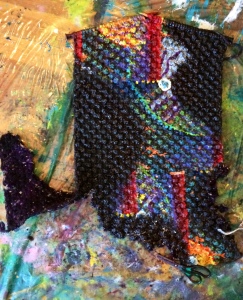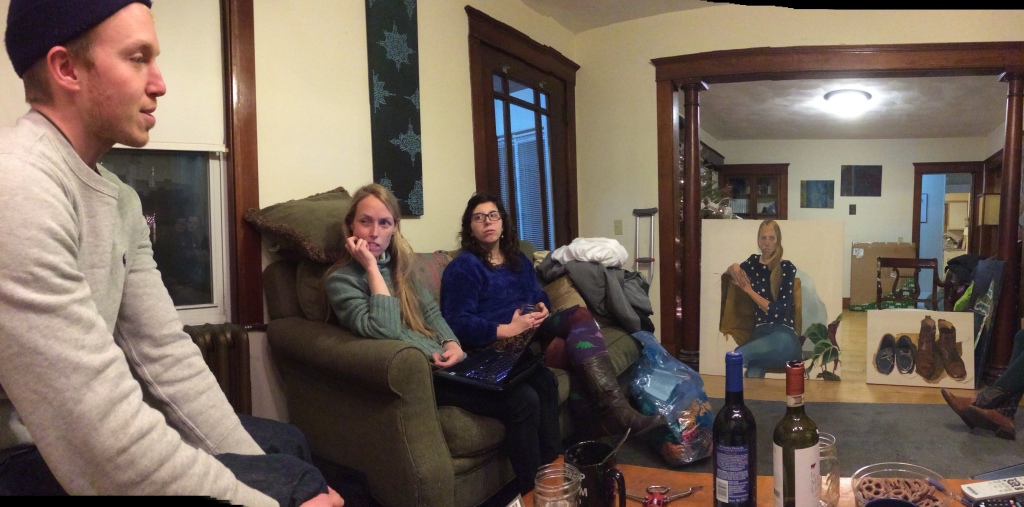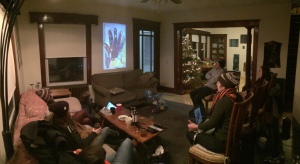Learning to Destroy
Last Friday I welcomed ten odd artists into my apartment. They arrived haphazardly; bundled against the cold and toting food to share and art to consider. They were all members of the Boston Critique Group whose monthly meetings I have sporadically attended since I crossed paths with the founder, Katherine Vetne, over two years ago.
Over the course of three hours, we looked at the work of seven artists, ranging from painters to fiber artists to potters. Much of the discussion for the evening focused on process: how to know when a work is finished, how to find the next series, how to exhibit process in a gallery. When it came time for these trained artists to turn their eye to my work, the same questions arose in regards to my current series of knitted canvasses.
The seed for this series was a side project from when I was working on my undergraduate thesis show. While painting on eight foot by eight foot unstretched canvas, I found myself drawn into the weave of the canvas itself. Canvas, I realized, was just fabric and as a knitter I make fabric, so why not knit my canvas? It was a simple enough idea that has led to nearly four years of tension in my artwork.
Now, to keep from exaggerating, I must acknowledge that during those four years I changed cities, went to graduate school, wrote a book, worked full-time, and started an art center. This left little room for deep rumination about my artwork and what it meant. Only in the past month or two have I once again carved out the time to be in my studio for at least a few hours every week.
The artists looking at my work encouraged me to push the tension between the knitting and the painting, to let the knitting come to the foreground in a way that it hasn’t managed to yet. One suggestion was to figure out how to destroy the perfect rectangles that have defined these pieces for the entirety of the series.
Early on in my undergraduate career, my painting mentor had suggested a similar approach. When a friend in the studio became to attached to a stale piece, he encouraged her to half-destroy it. Irritated, she decided to take him at his word and took her paper drawing outside to burn it. The drawing did not satisfactorily burst into flames due to the gesso on the piece. Instead, it charred at the edges and created lines of it’s own which turned out to be exactly what the piece was missing.
 Now, I have never been one to be afraid of destroying my artwork. If anything, I tend in the opposite direction and have to remind myself to only half destroy. But, as happens when you stare to closely at something, I had never considered destroying the knitted element of my knitted canvasses in the way that I did so mercilessly with the paint. By the end of the night, I was eager to shut the door on the last artist in order to run upstairs and take a pair of scissors to the knitted canvas that had been giving me so much trouble.
Now, I have never been one to be afraid of destroying my artwork. If anything, I tend in the opposite direction and have to remind myself to only half destroy. But, as happens when you stare to closely at something, I had never considered destroying the knitted element of my knitted canvasses in the way that I did so mercilessly with the paint. By the end of the night, I was eager to shut the door on the last artist in order to run upstairs and take a pair of scissors to the knitted canvas that had been giving me so much trouble.
Kid scissors, it turns out, does not destroy a thick, knitted and gessoed canvas particularly well. And so I went to bed with my painting only half cut, convinced that I had ruined a piece that I have been working on for nearly two years. Thankfully, at this point I have destroyed enough things to know that the fear and regret I was feeling post-destruction are often predecessors to the next breakthrough.



Pingback: Satta Matka()
Pingback: reserver hotel pas cher()
Pingback: buy backlinks()
Pingback: seks izle()
Pingback: sekiz izle()
Pingback: sekis izle()
Pingback: sekiz izle()
Pingback: marketing()
Pingback: Commercial Property for Sale in Miami()
Pingback: anami sikin()
Pingback: Bulk URL Shortener()